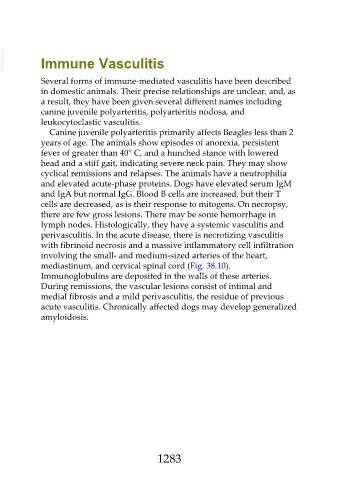Page 1283 - Veterinary Immunology, 10th Edition
P. 1283
VetBooks.ir Immune Vasculitis
Several forms of immune-mediated vasculitis have been described
in domestic animals. Their precise relationships are unclear, and, as
a result, they have been given several different names including
canine juvenile polyarteritis, polyarteritis nodosa, and
leukocytoclastic vasculitis.
Canine juvenile polyarteritis primarily affects Beagles less than 2
years of age. The animals show episodes of anorexia, persistent
fever of greater than 40° C, and a hunched stance with lowered
head and a stiff gait, indicating severe neck pain. They may show
cyclical remissions and relapses. The animals have a neutrophilia
and elevated acute-phase proteins. Dogs have elevated serum IgM
and IgA but normal IgG. Blood B cells are increased, but their T
cells are decreased, as is their response to mitogens. On necropsy,
there are few gross lesions. There may be some hemorrhage in
lymph nodes. Histologically, they have a systemic vasculitis and
perivasculitis. In the acute disease, there is necrotizing vasculitis
with fibrinoid necrosis and a massive inflammatory cell infiltration
involving the small- and medium-sized arteries of the heart,
mediastinum, and cervical spinal cord (Fig. 38.10).
Immunoglobulins are deposited in the walls of these arteries.
During remissions, the vascular lesions consist of intimal and
medial fibrosis and a mild perivasculitis, the residue of previous
acute vasculitis. Chronically affected dogs may develop generalized
amyloidosis.
1283

